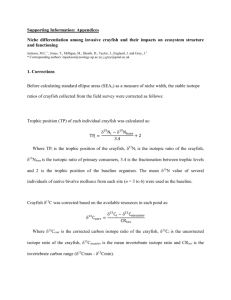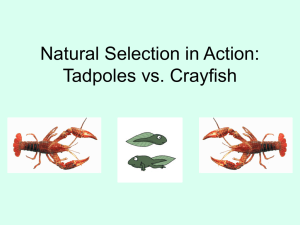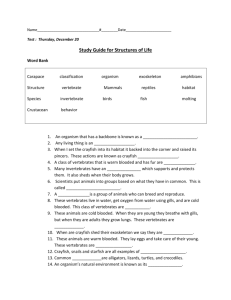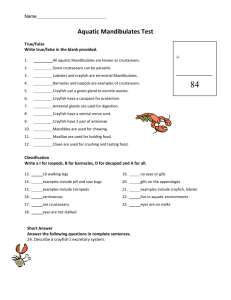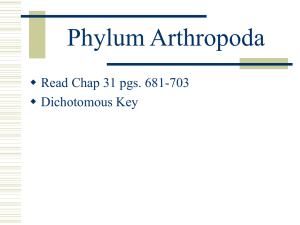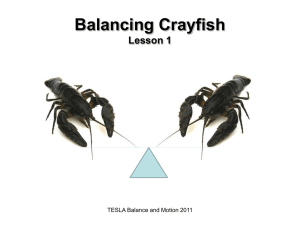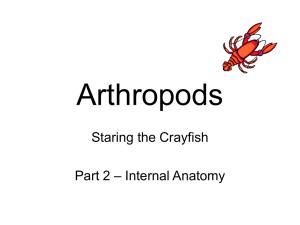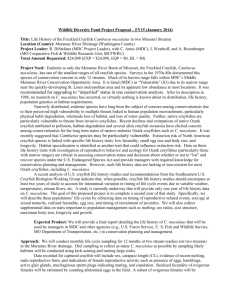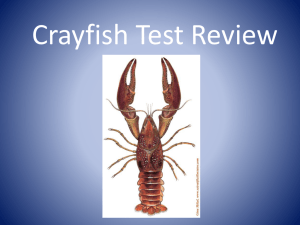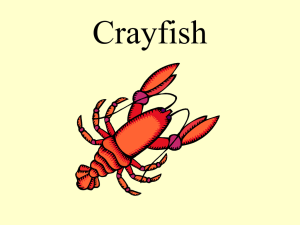VTEI 6/2011 Natural and artificial radionuclides in river bottom
advertisement
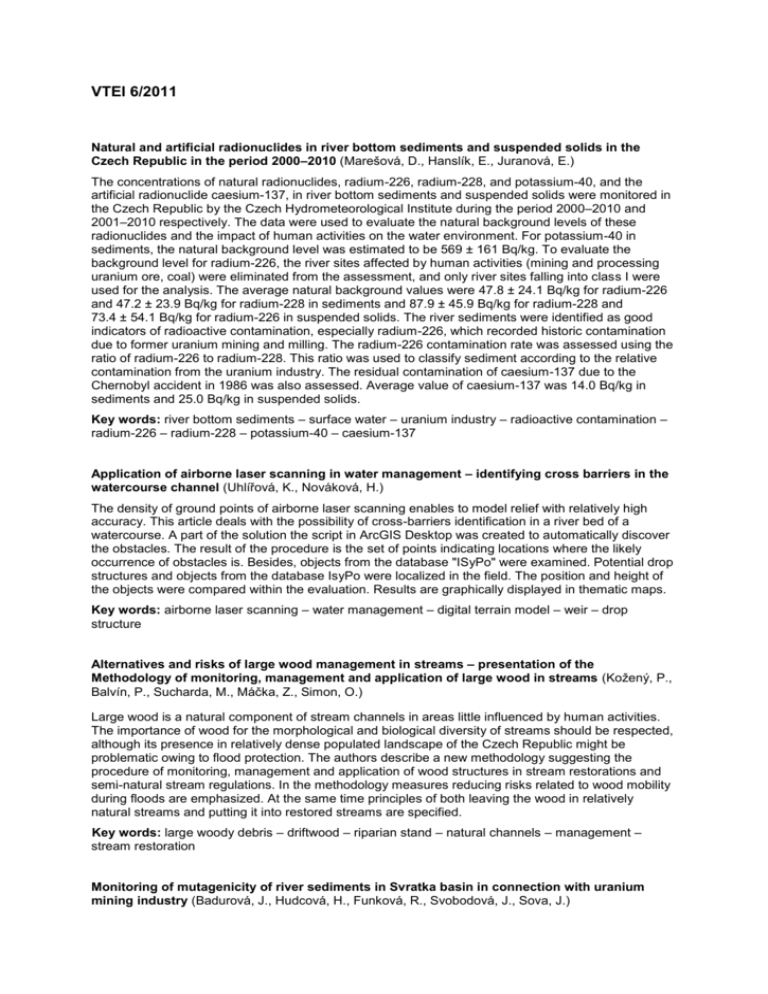
VTEI 6/2011 Natural and artificial radionuclides in river bottom sediments and suspended solids in the Czech Republic in the period 2000–2010 (Marešová, D., Hanslík, E., Juranová, E.) The concentrations of natural radionuclides, radium-226, radium-228, and potassium-40, and the artificial radionuclide caesium-137, in river bottom sediments and suspended solids were monitored in the Czech Republic by the Czech Hydrometeorological Institute during the period 2000–2010 and 2001–2010 respectively. The data were used to evaluate the natural background levels of these radionuclides and the impact of human activities on the water environment. For potassium-40 in sediments, the natural background level was estimated to be 569 ± 161 Bq/kg. To evaluate the background level for radium-226, the river sites affected by human activities (mining and processing uranium ore, coal) were eliminated from the assessment, and only river sites falling into class I were used for the analysis. The average natural background values were 47.8 ± 24.1 Bq/kg for radium-226 and 47.2 ± 23.9 Bq/kg for radium-228 in sediments and 87.9 ± 45.9 Bq/kg for radium-228 and 73.4 ± 54.1 Bq/kg for radium-226 in suspended solids. The river sediments were identified as good indicators of radioactive contamination, especially radium-226, which recorded historic contamination due to former uranium mining and milling. The radium-226 contamination rate was assessed using the ratio of radium-226 to radium-228. This ratio was used to classify sediment according to the relative contamination from the uranium industry. The residual contamination of caesium-137 due to the Chernobyl accident in 1986 was also assessed. Average value of caesium-137 was 14.0 Bq/kg in sediments and 25.0 Bq/kg in suspended solids. Key words: river bottom sediments – surface water – uranium industry – radioactive contamination – radium-226 – radium-228 – potassium-40 – caesium-137 Application of airborne laser scanning in water management – identifying cross barriers in the watercourse channel (Uhlířová, K., Nováková, H.) The density of ground points of airborne laser scanning enables to model relief with relatively high accuracy. This article deals with the possibility of cross-barriers identification in a river bed of a watercourse. A part of the solution the script in ArcGIS Desktop was created to automatically discover the obstacles. The result of the procedure is the set of points indicating locations where the likely occurrence of obstacles is. Besides, objects from the database "ISyPo" were examined. Potential drop structures and objects from the database IsyPo were localized in the field. The position and height of the objects were compared within the evaluation. Results are graphically displayed in thematic maps. Key words: airborne laser scanning – water management – digital terrain model – weir – drop structure Alternatives and risks of large wood management in streams – presentation of the Methodology of monitoring, management and application of large wood in streams (Kožený, P., Balvín, P., Sucharda, M., Máčka, Z., Simon, O.) Large wood is a natural component of stream channels in areas little influenced by human activities. The importance of wood for the morphological and biological diversity of streams should be respected, although its presence in relatively dense populated landscape of the Czech Republic might be problematic owing to flood protection. The authors describe a new methodology suggesting the procedure of monitoring, management and application of wood structures in stream restorations and semi-natural stream regulations. In the methodology measures reducing risks related to wood mobility during floods are emphasized. At the same time principles of both leaving the wood in relatively natural streams and putting it into restored streams are specified. Key words: large woody debris – driftwood – riparian stand – natural channels – management – stream restoration Monitoring of mutagenicity of river sediments in Svratka basin in connection with uranium mining industry (Badurová, J., Hudcová, H., Funková, R., Svobodová, J., Sova, J.) Since 2006, tests focused on assessment of mutagenic effect of samples of river sediments, which are influenced by uranium mining, have been carried out in the region of Olší-Drahonín and Rožná. Positive results were found in the samples of the sediments from the region of Olší–Drahonín by the Ames test, concretely by both strains TA 98 and TA 100. Samples from the sites Hadůvka-under ČDV and Hadůvka-Skryje were repetitively positive in mutagenicity test during all the monitoring period. However, sediments from the monitored region did not show cytotoxic effects on bacteria strains P. phosphoreum and S. typhimurium. Key words: radionuclide – uranium – heavy metal – mutagenicity – toxicity – Ames test – luminescent test – sediment Accidental pollution and lag time of travel – study for two objects in the Odra River basin (Šajer, J.) This article is focused on the determination of the lag time of travel of the accidental pollution between the objects located in the Odra River basin and the gage station on the Odra River in Bohumín. Two objects were chosen. The first object is BorsodChem MCHZ , s.r.o., which is located on the right bank of the Odra River. The second object is ArcelorMittal Ostrava, a.s., which is located on the left bank of the Lučina River. The Lučina River is the tributary of the Ostravice River, the tributary of the Odra River. Results of four following methods were used: hydraulic method , hydrometrical method, chemical „velocity“ method and estimation lag of travel from time of travel water surfaces. Key words: accidental pollution – lag time of travel – Odra River basin Is it possible to determine the correct concentration of pharmaceutics in waters? (Váňa, M., Matoušová, L., Fuksa, JK., Wanner, F.) The article points out the complexity of the issue of drugs and their determination in waters where in most cases the authors deal only with primary substances and do not look into the presence of metabolites of these compounds. In several cases there is discussed the complexity of the issue and danger associated with simplifying of obtained results interpretation. Key words: pharmaceutics – specific pollutants – determination – water – transformation – WWTP The evaluation of the influence of Dalešice – Mohelno dams on phytoplankton of the Jihlava River (Sedláček, P.) The intensity of the sun radiation and the amount of available nutrients are of the main importance for primary production. Due to the continuous water repumping, the stratification of phytoplankton is affected, which contributes to the decrease of algal abundance at the downstream-end profile, as indicated by up to a ten times lower chlorophyll-a concentration compared to the upstream profiles. The average values of trophic potential are the same above and below the dam system in recent years, which is a consequence of water destratification and the input of nutrients concentrated in the cooling systems of the Dukovany nuclear power plant by the Skryjský brook. Key words: phytoplankton – abundance – chlorophyll-a – trophic potential – dam – Dalešice–Mohelno dam system The loss of crayfish in the Padrťský brook (Klabava) is probably caused by the presence of heavy metals (Svobodová, J., Fischer, D., Kozubíková, E.) The Padrťsko region was included into the list of the Sites of Community Importance (SCIs) because of the occurrence of critically endangered stone crayfish (Austropotamobius torrentium Schrank, 1803). In the spring 2011, number of noble crayfish (Astacus astacus Linnaeus, 1758) and stone crayfish specimens were found dead in Padrťský brook. It was possible to find dead crayfish in the brook less frequently until the beginning of the summer. An analysis of crayfish gill tissue showed that respiration of these specimens was decreased by precipitation of iron, aluminium, zinc, copper and arsenic into insoluble compounds covering the gill surface, so that the imminent reason for the loss of the majority of crayfish could be, with the highest probability, suffocation. The autopsy showed that one specimen was also infected by microsporidia Telophania contejeani Henneguy, 1892. Nevertheless, this parasite only exceptionally represents the imminent reason of crayfish mass mortalities. In muscles of some larger crayfish individuals, higher concentrations of toxic metals, i.e. arsenic and cadmium, were found. Consequently, this could cause acute or chronic poisoning of animals. However, it is unclear whether this is the precise cause of death and ultimately the reason for the loss of the crayfish. The number of crayfish analysed in this study was too low to explain the described mass mortality properly. Also the information about the water quality in Padrťský brook and its tributaries were obtained accidentally and only data from the vegetation period were available. Therefore, the data are insufficient and the case requires further research to support our conclusions about the reason of crayfish mortality in order to prevent further losses of crayfish and perhaps even to save the current protected region of Padrťsko itself, because without the crayfish, no area protection would be needed. Key words: noble crayfish – stone crayfish – heavy metals – bioaccumulation Variability of phosphorus yield and concentration from agricultural land in the microscale (Fiala, D., Rosendorf, P.) The amount of phosphorus leaving a watershed is nearly negligible from farm gate budget point of view. But the opposite is true for watershed budget used by water management. To understand different sources of variability in P concentration, load and specific yield, we observed eleven profiles within one headwater catchment (15 km2). For three years (2007–2009) we sampled selected profiles for P concentration and other chemical parameters in one-month intervals and measured the discharge directly. All headwaters are located in the Švihov water supply reservoir watershed and none of them was settled. Thus we are able to generalize our results as a representation of exclusively non-point sources of pollution in the Czech Republic. Our study will also serve as a part of farm-gate budget to bring data to the wider and more important European context. Key words phosphorus – eutrophication – non-point sources of pollution – headwaters – Švihov Reservoir

